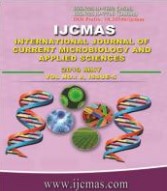


 National Academy of Agricultural Sciences (NAAS)
National Academy of Agricultural Sciences (NAAS)

|
PRINT ISSN : 2319-7692
Online ISSN : 2319-7706 Issues : 12 per year Publisher : Excellent Publishers Email : editorijcmas@gmail.com / submit@ijcmas.com Editor-in-chief: Dr.M.Prakash Index Copernicus ICV 2018: 95.39 NAAS RATING 2020: 5.38 |
A two year field experiment was conducted to elucidate relation of abscission of fruiting structures in cotton (Gossypium hirsutum) with abiotic factors and effect of agronomic intervention viz., spacing (90 × 60 cm and 90 × 45 cm) and NPK levels (50:25:25, 62.5:31.25:31.25 and 75:37.5:37.5 kg NPK ha-1) on abscission of fruiting structures, leaf reddening and chlorophyll content in Bt and non-Bt cotton of same genotype, following split plot design with 4 replicates at Akola. Abscission of fruiting structures increased linearly with increase in morning relative humidity and number of rainy days in a week. However, relations with minimum temperature, evening relative humidity and rainfall were non linear and varied according to their range. Minimum temperature range of 20-22 °C, evening relative humidity beyond 52% and rainfall more than 60 mm in a week were most critical for abscission. Bt cotton lost more fruiting structures through abscission, recorded maximum leaf reddening, but gave higher seed cotton yield. Whereas, non-Bt recorded maximum chlorophyll content. Spacing of 90 x 45 cm compensated abscission losses and recorded higher seed cotton yield than 90 x 60 cm. Application of 75:37.5:37.5 kg NPK ha-1 recorded higher seed cotton yield by minimizing abscission and leaf reddening with improvement in chlorophyll content but was at par with 62.5:31.25:31.25 kg NPK ha-1. Thus, it can be conclude that to harness higher seed cotton yield under rainfed condition Bt cotton should be sown at 90 x 45 cm spacing and fertilized with 62.5:31.25:31.25 kg NPK ha-1.
 |
 |
 |
 |
 |